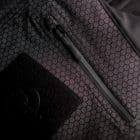In spite of starting my career in the Army, I retired from the Air Force. Although I worked primarily in the intelligence business, I served on jump status during various SOF assignments in both services.

One of the easiest ways to deduce if an Air Force Officer is an Academy graduate is that they have jump wings (that is if they haven’t already told you). That’s because the AFA offers a course in skydiving.

The AFA’s Basic Freefall Parachuting course, known as Airmanship 490 (AM-490), is run by a cadre of Cadets who make up the Academy’s free fall team, the Wings of Blue. The team and course operate as the 98th Flying Training Squadron, 306th Flying Training Group, Air Education and Training Command.

The course website boasts:
Each year, over 700 cadets take the AM-490 course, “Stand In The Door”, and earn their jump wings.
Here’s an example of the instruction:

If you’re a static-line parachutist, you’ll wonder what they’re up to and how this translates into jump wings.
While it’s true that there are many members of the Army who attend Basic Airborne Training early in their service, but never jump again, many others are assigned to jump billets later on their careers and use the skills that they were taught as Privates or Lieutenants. But that’s not what happening at the Air Force Academy, because it’s impossible to serve as a parachutist after graduating form the Academy’s AM-490 course of instruction.
The most important issue at hand is that Cadets who complete the program do not learn a military skill, despite being awarded a badge which indicates otherwise.
AFI 11-410 (Personal Parachute Operations) governs management of the Air Force parachuting program. It states:
6.3.2. USAF Academy Parachutist Qualification. Members on active parachute status who are quali- fied as USAF Academy parachutists are authorized to fill validated parachute positions and student authorizations at the USAF Academy. These parachutists are not authorized to fill parachute positions elsewhere (emphasis added) unless qualified through paragraphs 6.3.1. or 6.6. This qualification requires completion of one of the following formal training programs:
6.3.2.1. AM-490, USAF Academy, CO. AM-490 satisfies the qualification requirement for assignment to parachute positions and student authorizations at the USAF Academy and may be completed after assignment selection provided the member is a parachute volunteer.
6.3.2.2. AM-492, USAF Academy, CO. Completion of the jumpmaster curriculum in AM-492 qualifies members to serve as jumpmasters for USAF Academy operations only.
To reference back to paragraph 6.3.1 which covers S/L training:
6.3.1.1. US Army Basic Airborne Course, Ft. Benning, GA.
6.3.1.2. S/L courses or programs of instruction, including Mobile Training Teams (MTTs), approved by the US Army Infantry Center (USAIS).
6.3.1.3. US Navy Special Warfare Command (NAVSPECWARCOM) Naval Parachute School (S/ L Course).
6.3.1.4. AM-490, USAF Academy, CO, when the diploma was earned prior to August 1994. (emphasis added)
To reference back to paragraph 6.6 which covers MFF training:
6.6.1. US Army John F. Kennedy Special Warfare Center and School (USAJFKSWCS) Military Free Fall School, Yuma Proving Grounds, AZ.
6.6.2. MFF courses or programs of instruction, including MTTs, approved by USAJFKSWCS.
6.6.3. NAVSPECWARCOM Naval Parachute School (MFF Course), Naval Air Weapons Station China Lake, CA.
To summarize what those paragraphs mean for graduates of AM-490; to actually serve as a military parachutist, they have to attend one of the courses of instruction mentioned above.
As you can see, Cadets can’t earn advanced ratings. They aren’t filing J-coded billets. They aren’t static line parachutists and they aren’t military free fall parachutists. So what are they? That’s simple; they’re skydivers. The USAFA is creating about 700 new skydivers per year.

Although it hasn’t been the case for quite some time, over two decades ago Cadets were even allowed to earn Senior and Master parachutist ratings, based on skydives (see above). They selected their own jumpmasters and considered wearing smoke canisters or the flag during demonstration jumps as “combat equipment” jumps.

A few years ago, BG Goodwin, an AFA Commandant, wore Senior jump wings which she had been awarded as a Cadet. It caused a bit of confusion for actual parachutists who questioned her qualification, considering she had never served on jump status.

Even today, there are still a few senior officers a running around wearing badges they were awarded, but didn’t earn in the way parachutists would expect. That same argument could be made about those current and former Cadets wearing Basic wings. They aren’t qualified as parachutists.
Instead of awarding the basic parachutist badge, Cadets who complete the course should be awarded a cadets-only badge. There is already plenty of precedent for the concept. Cadets learn to fly gliders and even powered aircraft while at the Academy, but they aren’t awarded USAF pilot wings once they complete training. Why even the Space and Cyber communities have clubs for perspective members of their careerfields, but they don’t award actual careerfield badges. Instead, Cadets earn badges they only wear while at the Academy. Many of these are shared with Air Force ROTC.

Here’s a list of the many badges which can be earned by Air Force Academy Cadets:
Superintendent’s Pin: Worn only by those cadets whose name appears on the Superintendent’s list for obtaining the Commandant’s Pin, Dean’s Pin, and Athletic Director’s Pin for the previous semester.
Commandant’s Pin: Worn by those cadets whose name appears on the Commandant’s List. The Commandant’s List is reserved for cadets in the top one third in military performance by class. They will retain this status until the end of the next academic semester.
Dean’s Pin: Worn by those cadets whose name appears on the Dean’s list for obtaining a Grade Point Average of a 3.0 or above for the previous semester.
Athletic Director’s Pin: Athletic Director’s Pin: Worn by those cadets who obtain a semester Physical Education Average (PEA) of at least 3.00 during the academic year. The PEA is based on 50% Physical Fitness Test score, 15% Aerobic Fitness Test score and 35% P.E. class grade. Cadets on any probation do not qualify for the Athletic Director’s pin.
Combinations of the Commandant’s Pin, Dean’s Pin, and Athletic Director’s Pin are worn to signify attainment of placement on multiple lists the previous semester.
Soaring Instructor Pilot Wings: World War II glider pilot wings awarded to cadet soaring instructor pilots upon completion of AM-461. A star and wreath are added as cadets progress through the soaring program.
Flying Team Wings: Approved in October 2012, these wings are worn by members of the Flying Team, a select group of cadets who were selected after arriving at the Air Force Academy with a Private Pilot’s license. A star and wreath are added as cadets progress through the soaring program.
Cadet Flight Wings: Flight wings with star are worn by cadets who have soloed a USAFA glider or a powered aircraft. Wings without star are worn by cadets who have completed at least 10 flights in a USAFA glider but have not soloed.
Cadet Aviation Club Wings: Worn by cadet aviation instructors. A star is added for a senior cadet aviation instructor.
Cadet Space Wings: Worn by cadets who are involved in space activities. A star and wreath are added as cadets progress through the space program.
Cadet Cyberwarfare Badge: Worn by cadets to acknowledge the achievement of cadets who are involved in the cyberwarfare program. A star and wreath are added as cadets progress through the cyber program.
Parachutist Badge: Worn by those cadets who have successfully completed either the Airmanship 490 Basic Parachuting course taught by the 98 FTS or graduates of the US Army Basic Airborne Course, Ft. Benning, GA. Senior and Master Parachutist badges require operational experience and are awarded as authorized in AFI 11-402.
Air Assault Badge: Worn by those cadets who have successfully completed US Army Basic Air Assault School.
Bulldog Badge: Worn by those cadets who have completed the Marine Corps Bulldog program at Quantico, VA.
UAS Wings: Worn by cadets who have completed Small UAS (SUAS) certification. A star and wreath are added as cadets progress through the UAS program as instructors and evaluators/test pilots.
Here are a couple of examples.
Cadet Cyberspace Badge

Cyberspace Operator Badge

Cadet Flight Wings

Air Force Pilot Badge

The choice for a Cadet Skydiving Badge is easy. From 1956-1963, the USAF awarded a distinctive badge for Air Force parachutists. Based on the shield now worn by medical personnel, it featured a light blue background emblazoned with a white parachute.

Not only is this design distinctive, but it’s no longer used by the Air Force yet supports the service’s heritage. It’s the perfect design for our skydiving cadets. There are even Senior and master versions. The master variant is seen below.

In 1963, the Air Force switched back to the basic parachutist badge used by the other services.

As you can imagine, some AFA cadets do in fact attend the three-week BAC at Fort Benning, Gerorgia. That course teaches a military skill and graduates are awarded basic airborne wings. Just like cadets who attend Air Assault school, they earn their wings.
It’s not that the training isn’t valuable. It should continue. There’s no operational requirement to pilot a glider, but the skill does teach airmanship. Likewise, skydiving teaches Cadets about aviation and instills confidence. As an airmanship course of instruction, it should continue.

This isn’t the fault of the Airmen, but rather the institution. The Air Force is failing to prepare them for the mission. Recently, AETC attempted to set up its own MFF training program to help streamline its Special Warfare training pipelines with the eventual goal of adding S/L as well. The Air Force scrapped the project when it realized it couldn’t adequately replicate the exacting conditions and standards of the formal courses of instruction already mentioned.
Even the Academy has halted training that didn’t adequately prepare its students for operational roles. At one time, Cadets participated in Survival Evasion Resistance and Escape training run by Cadets at the Academy. When it was determined that it didn’t adequately prepare students for operational requirements, the Resistance portion of the the training was halted and Cadets who required it, received the training as part of the formal course at Fairchild, once commissioned. The Survival and Evasion training continues as part of Basic Cadet Training as it instills confidence and teaches basic outdoor living skills.
Creation of a Cadet Skydiving Badge aligns with other aeronautical programs at the Air Force Academy, recognizing unique skills taught at that institution, while reserving the parachutist badge for those who are actually qualified to fulfill operational duties as parachutists in the operational Air Force.
Very recently, the Air Force asked for feedback regarding dress and appearance, but as I am now retired, my input is understandably not wanted. However, this issue continues to affect the active force. Perhaps others who continue to serve, will make similar suggestions.

































































































































